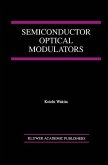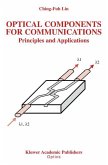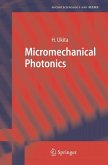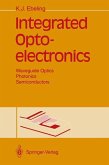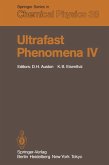Photonic Devices for Telecommunications
How to Model and Measure
Herausgegeben:Guekos, George
Photonic Devices for Telecommunications
How to Model and Measure
Herausgegeben:Guekos, George
- Broschiertes Buch
- Merkliste
- Auf die Merkliste
- Bewerten Bewerten
- Teilen
- Produkt teilen
- Produkterinnerung
- Produkterinnerung
This book is subdivided into three main Parts. The common spirit in these parts is to provide, at the beginning of each, a comprehensive introduction into the subject treated, followed by specific aspects pertaining to the modelling and/or measuring particularities arlsmg from the investigation of photonic devices for telecommunications. Some of the devices treated here can be considered as widely known and well established. Others are rather new and their potential for applications is not yet fully exploited. The methods to model and measure photonic in this book and the comparison of results…mehr
Andere Kunden interessierten sich auch für
![Photonic Networks Photonic Networks]() Photonic Networks74,99 €
Photonic Networks74,99 €![Photonic Switching II Photonic Switching II]() Photonic Switching II77,99 €
Photonic Switching II77,99 €![Semiconductor Optical Modulators Semiconductor Optical Modulators]() Koichi WakitaSemiconductor Optical Modulators116,99 €
Koichi WakitaSemiconductor Optical Modulators116,99 €![Optical Components for Communications Optical Components for Communications]() Ching-Fuh LinOptical Components for Communications38,99 €
Ching-Fuh LinOptical Components for Communications38,99 €![Micromechanical Photonics Micromechanical Photonics]() Hiroo UkitaMicromechanical Photonics77,99 €
Hiroo UkitaMicromechanical Photonics77,99 €![Integrated Optoelectronics Integrated Optoelectronics]() Karl J. EbelingIntegrated Optoelectronics75,99 €
Karl J. EbelingIntegrated Optoelectronics75,99 €![Ultrafast Phenomena IV Ultrafast Phenomena IV]() Ultrafast Phenomena IV77,99 €
Ultrafast Phenomena IV77,99 €-
-
-
This book is subdivided into three main Parts. The common spirit in these parts is to provide, at the beginning of each, a comprehensive introduction into the subject treated, followed by specific aspects pertaining to the modelling and/or measuring particularities arlsmg from the investigation of photonic devices for telecommunications. Some of the devices treated here can be considered as widely known and well established. Others are rather new and their potential for applications is not yet fully exploited. The methods to model and measure photonic in this book and the comparison of results obtained devices and structures outlined by applying such methods are likely to interest both the engineer investigating the of a device in a system and the engineer looking for new ways to explore behaviour the possibilities offered by emerging devices. Many authors have contributed to this book. There are two main reasons for this. in photonic device research, modelling First, the book addresses two broad fields and measurements, for which a vast knowledge exists in many research groups that was not integrated in a book before. Second, a significant number of laboratories decided to closely co-operate in order to gain additional information on merits and drawbacks of their own methods for simulation and experimentation of devices as compared to the methods used by their colleagues in other laboratories. The outcome are new aspects and approaches that would not have been investigated in the absence of a framework for a co-operative programme.
Produktdetails
- Produktdetails
- Verlag: Springer / Springer Berlin Heidelberg / Springer, Berlin
- Artikelnr. des Verlages: 978-3-642-64168-8
- Softcover reprint of the original 1st ed. 1999
- Seitenzahl: 440
- Erscheinungstermin: 21. Januar 2012
- Englisch
- Abmessung: 235mm x 155mm x 24mm
- Gewicht: 662g
- ISBN-13: 9783642641688
- ISBN-10: 3642641687
- Artikelnr.: 36113636
- Verlag: Springer / Springer Berlin Heidelberg / Springer, Berlin
- Artikelnr. des Verlages: 978-3-642-64168-8
- Softcover reprint of the original 1st ed. 1999
- Seitenzahl: 440
- Erscheinungstermin: 21. Januar 2012
- Englisch
- Abmessung: 235mm x 155mm x 24mm
- Gewicht: 662g
- ISBN-13: 9783642641688
- ISBN-10: 3642641687
- Artikelnr.: 36113636
I Photonic Waveguide Structures.- 1 Mode solvers and related methods.- 1.1 MoL mode solver using enhanced line algorithm.- 1.1.1 Theoretical foundation of the algorithm.- 1.1.2 Determination of matrices.- 1.1.3 Numerical results.- 1.2 Film-mode matching with relation to BEP and MoL.- 1.2.1 Reference model geometry.- 1.2.2 Theory.- 1.2.3 Numerical considerations.- 1.2.4 Discussion.- 1.2.5 Conclusion.- 1.3 Free space radiation mode method.- 1.3.1 Polarised and vectorial modal analysis of buried waveguides.- 1.3.2 Waveguide facet reflectivities.- 1.3.3 Propagation in 3D structures.- References.- 2 Beam propagation methods.- 2.1 Finite difference beam propagation method basic formulae and improvements.- 2.1.1 Finite difference BPM equations in 2D.- 2.1.2 Applicability.- 2.1.3 Applications.- 2.2 Beam propagation method based on the method of lines.- 2.2.1 Theory.- 2.2.2 Special case: very thin layers.- 2.3 Bi-directional eigenmode expansion and propagation method.- 2.4 Method of backward calculation.- 2.4.1 Description of the method.- 2.4.2 Application to distributed Bragg reflectors.- References.- 3 Benchmark tests and modelling tasks.- 3.1 BPM benchmark tests.- 3.1.1 Tilted waveguides.- 3.1.2 Square meander coupler.- 3.1.3 Gain-loss waveguide benchmark test.- 3.1.4 Directional coupler benchmark test.- 3.2 Wave propagation in a waveguide with a balance of gain and loss.- 3.2.1 Quasi-analytic solution.- 3.2.2 Wave growth in the gain-loss waveguide with lossless eigenmodes.- 3.3 Waveguide tapers.- 3.3.1 Modelling task and reciprocity test.- 3.3.2 Numerical results.- 3.3.3 Discussion.- 3.3.4 Conclusion.- 3.4 Electro-optic modulator based on surface plasmons.- 3.4.1 Problem definition.- 3.4.2 About the computational methods.- 3.4.3 Results and discussion.- 3.4.4 Conclusions.- 3.5 Waveguide Bragg grating filter.- 3.5.1 Formulation of the problem.- 3.5.2 Outline of computational methods applied.- 3.5.3 Numerical results.- 3.5.4 Conclusions.- References.- 4 Methods for waveguide characterization.- 4.1 FP resonator method for loss and group index measurement.- 4.1.1 Waveguide loss determination.- 4.1.2 Group effective index determination.- 4.2 Optical low coherence reflectometry for group index, chromatic dispersion and loss measurements.- 4.2.1 Theory.- 4.2.2 OLCR experimental set-up.- 4.2.3 Calibration and performance of the system.- 4.2.4 Experimental results on simple lOCs.- 4.2.5 Experimental results on more complex lOCs.- 4.3 Near field imaging for mode profile measurement.- 4.3.1 Near field determination by imaging detectors.- 4.3.2 Near field determination by scanning a single-element detector.- 4.3.3 Practical aspects of near field imaging in the 1.3-1.55 ?m range.- 4.4 Transverse offset method for mode profile measurement.- 4.5 Spectral transmission method for cut-off wavelength measurements.- 4.5.1 Experimental set-up.- 4.5.2 Typical response.- 4.5.3 Conclusion.- References.- 5 Comparison of experimental results.- 5.1 Loss measurements.- 5.1.1 Loss measurements on rib waveguides.- 5.1.2 Loss measurements on diffused waveguides.- 5.2 Group index measurements.- 5.3 Mode profile measurements.- 5.4 Cut-off wavelength measurements.- References.- II Semiconductor Distributed Feedback Laser Diodes.- 6 Introductory physics.- 6.1 Historical background.- 6.2 Description of DFB and DBR laser diodes.- 6.2.1 Geometric structure.- 6.2.2 Threshold condition.- 6.2.3 Distributed reflections.- 6.3 Introduction to DFB laser characteristics.- 6.3.1 The P-I characteristic.- 6.3.2 The V-I characteristic.- 6.3.3 The optical spectrum.- 6.3.4 The modulation responses.- 6.3.5 The FM- and intensity noise spectra, the linewidth.- 6.4 Problems in modelling and measuring DFB laser diodes.- 6.5 General approximations used in laser diode modeling.- 6.6 Standardisation of laser parameters166.- 6.6.1 Derivation of an ASCII equivalent of a symbol.- 6.6.2 Optical output definitions.- 6.6.3 Cavity dimensions.- 6.6.4 Symbols used to describe internal variables.- 6.6.5 Optical waveguide parameters.- 6.6.6 Waveguide gratings.- 6.6.7 Stimulated emission parameters.- 6.6.8 Spontaneous recombination parameters.- 6.6.9 Current injection parameters.- References.- 7 Modelling of DFB laser diodes.- 7.1 Overview of laser models.- 7.1.1 Desirable characteristics of laser models.- 7.1.2 Single-mode rate equation laser models.- 7.1.3 Multi-mode rate equation laser models.- 7.1.4 Travelling-wave rate equation laser models.- 7.1.5 Transfer-matrix models.- 7.1.6 Fully time-domain models.- 7.1.7 Other numerical models.- 7.2 Numerical case studies.- 7.2.1 Introduction.- 7.2.2 AR-coated, A/4-shifted DFB lasers.- 7.2.3 DFB lasers with cleaved facets.- 7.2.4 Large signal dynamic behaviour of a A/4-shifted laser.- 7.2.5 Self pulsations of a multi-electrode laser.- References.- 8 Measurements on DFB lasers.- 8.1 Basic measurements.- 8.2 Emission linewidth and other more specific measurements.- 8.3 Measurement of dynamic characteristics.- 8.3.1 Aim of this work.- 8.3.2 Devices and measurements description.- 8.3.3 Measurement results: device "A".- 8.3.4 Measurement results: device "B".- 8.3.5 Parameter extraction from high frequency measurements.- References.- 9 Parameter extraction.- 9.1 General remarks on laser parameter extraction.- 9.2 Extraction from the ASE spectrum.- 9.2.1 Measurement of the ASE spectrum.- 9.2.2 Theoretical formula for ASE spectrum.- 9.2.3 Fitting technique.- 9.2.4 Comparative experimental results.- 9.3 Extraction from the RIN spectrum.- 9.3.1 Measurement of RIN.- 9.3.2 Theoretical formula for RIN.- 9.3.3 Parameter extraction example.- 9.4 Extraction from modulation response measurements.- 9.4.1 Measurement of modulation response.- 9.4.2 Theoretical formula for modulation response.- 9.4.3 Fitting procedure and extraction example.- 9.4.4 The concept of the three bandwidth limits.- 9.5 Other methods and the role of facet properties.- 9.5.1 Cross-check of extracted parameters by different methods.- 9.5.2 The role of facet properties.- References.- III Nonlinear Effects in Semiconductor Optical Amplifiers: Four-Wave Mixing.- 10 Why and how to study four-wave mixing?.- 10.1 Applications of semiconductor optical amplifiers.- 10.2 Principle of four-wave mixing.- 10.3 Efficiency and signal-to-background ratio.- References.- 11 Theory of four-wave mixing.- 11.1 Rate equations.- 11.2 Time-domain description.- 11.2.1 Derivation of the integral equation.- 11.2.2 Four-wave mixing between CW beams.- 11.3 Coupled mode theory.- 11.3.1 Fundamental equations.- 11.3.2 General assumptions.- 11.3.3 Saturation of the single-pass gain.- 11.3.4 Gain-cube theory.- 11.3.5 Inclusion of saturation effects.- 11.3.6 Inclusion of gain dispersion effects.- 11.3.7 Comparison with a numerical model.- 11.4 Noise analysis.- 11.4.1 Calculation of the ASE spectral density.- 11.4.2 Uniform inversion parameter.- 11.4.3 Nonuniform inversion parameter.- 11.4.4 Effect of gain dispersion.- 11.4.5 Comparison with measurements.- 11.4.6 Signal-to-background ratio.- 11.4.7 Noise figure.- References.- 12 Measurement techniques and results.- 12.1 Set-up.- 12.1.1 Sources.- 12.1.2 Tested device.- 12.1.3 Detection and filtering.- 12.1.4 Set-up examples.- 12.2 General results.- 12.2.1 FWM performance vs. optical input power.- 12.2.2 FWM performance vs. driving current.- 12.2.3 FWM performance vs. detuning.- 12.3 Round robin results.- 12.3.1 Device description.- 12.3.2 Comparison of the round robin results.- References.- 13 Related topics.- 13.1 Parameter extraction.- 13.1.1 Parameter extraction: first approach.- 13.1.2 Parameter extraction: second approach.- 13.1.3 Interpretation of the results.- 13.2 Cross gain modulation measurements.- 13.3 Nearly degenerated FWM measurements.- 13.3.1 Measurement set-up.- 13.3.2 Results.- 13.4 Effect of birefringence on four-wave mixing.- 13.4.1 Experimental set-up.- 13.4.2 Impact of birefringence on the conversion efficiency and the signal-to-background ratio.- 13.4.3 Polarisation resolved ASE measurements.- 13.5 Four-wave mixing experiments with picosecond optical pulses.- 13.5.1 Experimental set-up.- 13.5.2 Short pulse amplification in SOAs.- 13.5.3 Comparison of CW and pulsed FWM measurements.- References.- Appendix. An optical data interchange format.- Symbols.
I Photonic Waveguide Structures.- 1 Mode solvers and related methods.- 1.1 MoL mode solver using enhanced line algorithm.- 1.1.1 Theoretical foundation of the algorithm.- 1.1.2 Determination of matrices.- 1.1.3 Numerical results.- 1.2 Film-mode matching with relation to BEP and MoL.- 1.2.1 Reference model geometry.- 1.2.2 Theory.- 1.2.3 Numerical considerations.- 1.2.4 Discussion.- 1.2.5 Conclusion.- 1.3 Free space radiation mode method.- 1.3.1 Polarised and vectorial modal analysis of buried waveguides.- 1.3.2 Waveguide facet reflectivities.- 1.3.3 Propagation in 3D structures.- References.- 2 Beam propagation methods.- 2.1 Finite difference beam propagation method basic formulae and improvements.- 2.1.1 Finite difference BPM equations in 2D.- 2.1.2 Applicability.- 2.1.3 Applications.- 2.2 Beam propagation method based on the method of lines.- 2.2.1 Theory.- 2.2.2 Special case: very thin layers.- 2.3 Bi-directional eigenmode expansion and propagation method.- 2.4 Method of backward calculation.- 2.4.1 Description of the method.- 2.4.2 Application to distributed Bragg reflectors.- References.- 3 Benchmark tests and modelling tasks.- 3.1 BPM benchmark tests.- 3.1.1 Tilted waveguides.- 3.1.2 Square meander coupler.- 3.1.3 Gain-loss waveguide benchmark test.- 3.1.4 Directional coupler benchmark test.- 3.2 Wave propagation in a waveguide with a balance of gain and loss.- 3.2.1 Quasi-analytic solution.- 3.2.2 Wave growth in the gain-loss waveguide with lossless eigenmodes.- 3.3 Waveguide tapers.- 3.3.1 Modelling task and reciprocity test.- 3.3.2 Numerical results.- 3.3.3 Discussion.- 3.3.4 Conclusion.- 3.4 Electro-optic modulator based on surface plasmons.- 3.4.1 Problem definition.- 3.4.2 About the computational methods.- 3.4.3 Results and discussion.- 3.4.4 Conclusions.- 3.5 Waveguide Bragg grating filter.- 3.5.1 Formulation of the problem.- 3.5.2 Outline of computational methods applied.- 3.5.3 Numerical results.- 3.5.4 Conclusions.- References.- 4 Methods for waveguide characterization.- 4.1 FP resonator method for loss and group index measurement.- 4.1.1 Waveguide loss determination.- 4.1.2 Group effective index determination.- 4.2 Optical low coherence reflectometry for group index, chromatic dispersion and loss measurements.- 4.2.1 Theory.- 4.2.2 OLCR experimental set-up.- 4.2.3 Calibration and performance of the system.- 4.2.4 Experimental results on simple lOCs.- 4.2.5 Experimental results on more complex lOCs.- 4.3 Near field imaging for mode profile measurement.- 4.3.1 Near field determination by imaging detectors.- 4.3.2 Near field determination by scanning a single-element detector.- 4.3.3 Practical aspects of near field imaging in the 1.3-1.55 ?m range.- 4.4 Transverse offset method for mode profile measurement.- 4.5 Spectral transmission method for cut-off wavelength measurements.- 4.5.1 Experimental set-up.- 4.5.2 Typical response.- 4.5.3 Conclusion.- References.- 5 Comparison of experimental results.- 5.1 Loss measurements.- 5.1.1 Loss measurements on rib waveguides.- 5.1.2 Loss measurements on diffused waveguides.- 5.2 Group index measurements.- 5.3 Mode profile measurements.- 5.4 Cut-off wavelength measurements.- References.- II Semiconductor Distributed Feedback Laser Diodes.- 6 Introductory physics.- 6.1 Historical background.- 6.2 Description of DFB and DBR laser diodes.- 6.2.1 Geometric structure.- 6.2.2 Threshold condition.- 6.2.3 Distributed reflections.- 6.3 Introduction to DFB laser characteristics.- 6.3.1 The P-I characteristic.- 6.3.2 The V-I characteristic.- 6.3.3 The optical spectrum.- 6.3.4 The modulation responses.- 6.3.5 The FM- and intensity noise spectra, the linewidth.- 6.4 Problems in modelling and measuring DFB laser diodes.- 6.5 General approximations used in laser diode modeling.- 6.6 Standardisation of laser parameters166.- 6.6.1 Derivation of an ASCII equivalent of a symbol.- 6.6.2 Optical output definitions.- 6.6.3 Cavity dimensions.- 6.6.4 Symbols used to describe internal variables.- 6.6.5 Optical waveguide parameters.- 6.6.6 Waveguide gratings.- 6.6.7 Stimulated emission parameters.- 6.6.8 Spontaneous recombination parameters.- 6.6.9 Current injection parameters.- References.- 7 Modelling of DFB laser diodes.- 7.1 Overview of laser models.- 7.1.1 Desirable characteristics of laser models.- 7.1.2 Single-mode rate equation laser models.- 7.1.3 Multi-mode rate equation laser models.- 7.1.4 Travelling-wave rate equation laser models.- 7.1.5 Transfer-matrix models.- 7.1.6 Fully time-domain models.- 7.1.7 Other numerical models.- 7.2 Numerical case studies.- 7.2.1 Introduction.- 7.2.2 AR-coated, A/4-shifted DFB lasers.- 7.2.3 DFB lasers with cleaved facets.- 7.2.4 Large signal dynamic behaviour of a A/4-shifted laser.- 7.2.5 Self pulsations of a multi-electrode laser.- References.- 8 Measurements on DFB lasers.- 8.1 Basic measurements.- 8.2 Emission linewidth and other more specific measurements.- 8.3 Measurement of dynamic characteristics.- 8.3.1 Aim of this work.- 8.3.2 Devices and measurements description.- 8.3.3 Measurement results: device "A".- 8.3.4 Measurement results: device "B".- 8.3.5 Parameter extraction from high frequency measurements.- References.- 9 Parameter extraction.- 9.1 General remarks on laser parameter extraction.- 9.2 Extraction from the ASE spectrum.- 9.2.1 Measurement of the ASE spectrum.- 9.2.2 Theoretical formula for ASE spectrum.- 9.2.3 Fitting technique.- 9.2.4 Comparative experimental results.- 9.3 Extraction from the RIN spectrum.- 9.3.1 Measurement of RIN.- 9.3.2 Theoretical formula for RIN.- 9.3.3 Parameter extraction example.- 9.4 Extraction from modulation response measurements.- 9.4.1 Measurement of modulation response.- 9.4.2 Theoretical formula for modulation response.- 9.4.3 Fitting procedure and extraction example.- 9.4.4 The concept of the three bandwidth limits.- 9.5 Other methods and the role of facet properties.- 9.5.1 Cross-check of extracted parameters by different methods.- 9.5.2 The role of facet properties.- References.- III Nonlinear Effects in Semiconductor Optical Amplifiers: Four-Wave Mixing.- 10 Why and how to study four-wave mixing?.- 10.1 Applications of semiconductor optical amplifiers.- 10.2 Principle of four-wave mixing.- 10.3 Efficiency and signal-to-background ratio.- References.- 11 Theory of four-wave mixing.- 11.1 Rate equations.- 11.2 Time-domain description.- 11.2.1 Derivation of the integral equation.- 11.2.2 Four-wave mixing between CW beams.- 11.3 Coupled mode theory.- 11.3.1 Fundamental equations.- 11.3.2 General assumptions.- 11.3.3 Saturation of the single-pass gain.- 11.3.4 Gain-cube theory.- 11.3.5 Inclusion of saturation effects.- 11.3.6 Inclusion of gain dispersion effects.- 11.3.7 Comparison with a numerical model.- 11.4 Noise analysis.- 11.4.1 Calculation of the ASE spectral density.- 11.4.2 Uniform inversion parameter.- 11.4.3 Nonuniform inversion parameter.- 11.4.4 Effect of gain dispersion.- 11.4.5 Comparison with measurements.- 11.4.6 Signal-to-background ratio.- 11.4.7 Noise figure.- References.- 12 Measurement techniques and results.- 12.1 Set-up.- 12.1.1 Sources.- 12.1.2 Tested device.- 12.1.3 Detection and filtering.- 12.1.4 Set-up examples.- 12.2 General results.- 12.2.1 FWM performance vs. optical input power.- 12.2.2 FWM performance vs. driving current.- 12.2.3 FWM performance vs. detuning.- 12.3 Round robin results.- 12.3.1 Device description.- 12.3.2 Comparison of the round robin results.- References.- 13 Related topics.- 13.1 Parameter extraction.- 13.1.1 Parameter extraction: first approach.- 13.1.2 Parameter extraction: second approach.- 13.1.3 Interpretation of the results.- 13.2 Cross gain modulation measurements.- 13.3 Nearly degenerated FWM measurements.- 13.3.1 Measurement set-up.- 13.3.2 Results.- 13.4 Effect of birefringence on four-wave mixing.- 13.4.1 Experimental set-up.- 13.4.2 Impact of birefringence on the conversion efficiency and the signal-to-background ratio.- 13.4.3 Polarisation resolved ASE measurements.- 13.5 Four-wave mixing experiments with picosecond optical pulses.- 13.5.1 Experimental set-up.- 13.5.2 Short pulse amplification in SOAs.- 13.5.3 Comparison of CW and pulsed FWM measurements.- References.- Appendix. An optical data interchange format.- Symbols.




